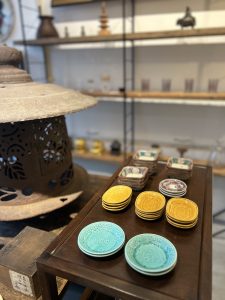朝ドラ「ばけばけ」の週タイトルが気になります(愛知県名古屋市千種区姫池通 骨董買取 古美術風光舎)
2025.10.26

現在NHKで放送されている朝ドラ「ばけばけ」にハマっております。日本に帰化し、日本の幽霊や民話を元にした「怪談」の著者である小泉八雲(ラフカディオ・ハーン)とその妻、小泉セツの波乱万丈の人生を描いた物語です。前回はセツの最初の夫との涙涙の別れのシーンでしたが、やはり史実を元に作られた朝ドラはある程度ストーリーの予想がつき(オープニングの映像からも明らかですが)、この夫とはいずれ別れるのだな、ラフカディオ・ハーンはいつ登場するのかな、などと考えながら観ることとなります。
小泉八雲の日本文化や日本人への理解の深さは並外ており、万物に神や精霊や宿ると信じる日本人の感覚に多大な影響を受けたとされています。「八雲」という日本名も古事記にある和歌の始祖とされる歌「八雲立つ 出雲八重垣 妻籠みに 八重垣作る その八重垣を」に由来しているのだとか。妻を守るために垣根を作る幸せな気持ちを表しているそうです。
予告では、いよいよ次週あたりに登場するようで楽しみです。
タイトルの「ばけばけ」とは「怪談」の中に出てくる「雪女」や「ろくろ首」などのいわゆる「お化け」の意味の他に、江戸時代から明治へと世の中が劇的に変化するなか、言葉も上手く通じない二人がいかに「化けて」変わっていくかという意味も込められているといいます。
「ばけばけ」というタイトルだけではなく、週ごとのタイトルも気になっておりました。第一週の「ブシムスメ、ウラメシ」、第二週の「ムコ、モラウ、ムズカシ」などです。明らかに外国の人が話すカタコトの日本語なのですが、このカタカナだけの助詞のない、文法を簡略化した日本語が小泉八雲とセツをつなぐ大切な言語であり、「怪談」などのベストセラー小説が生まれた重要なポイントとなるようです。
初めはお手伝いさんとして働いていた小泉セツがハーンの言葉をなんとか理解しようと書き留めた「単語帳」が残っているようで、靴はシウ、綿はカタン、酒はワエンなどハーンの発する言葉を聞こえた通りにメモしたようです。これらは後に「ヘルン言葉」と呼ばれるようになります。ハーンは名前の綴り「Hearn」から「ヘルン」さんと呼ばれるようになりました。セツが作った単語帳などを元にハーンもカタカナで日本語の文章を書くようになり、二人だけが理解する言葉で気持ちを通わせるようになったのだとか。
意思の疎通だけではなく、このヘルン語は小泉八雲が「怪談」などの物語を書く上で重要な役割を果たしました。小泉八雲がいかに優れた書き手だとしても、日本語が分からなければ日本の民話や幽霊話を知ることはできません。そこでセツが古本屋などで見つけた民話などを八雲に読み聞かせるのですが、八雲は本をそのまま読むことをよしとせず、本の内容を体に浸透させてから、セツの言葉で語るよう求めました。ちょっと荷が重すぎるのでは?とも思いますが、セツは擬音語や擬態語を織り交ぜながら、八雲の「その時どんな気持ちだと思う?」などの突っ込みにも応えながら物語を語ります。セツの語りからインスピレーションを受け、小泉八雲はあの幽玄な世界を描いていきました。これはもう小泉セツさんの作品でもあるのではないでしょうか。
お互いに相手の言語がカタコトだったからこそ一生懸命に耳を傾け、深い思いやりが生まれたのかもしれません。いや深い思いやりが先でしょうか?
「怪談」には雪女、ろくろ首など有名なお話が収められていますが、子供の頃の私にとっては何と言っても「耳なし芳一」が強烈でした。目の見えない芳一に感情移入してしまい、真っ暗なお墓の中で幽霊囲まれているのに、華やかな宮廷で琵琶を奏でていると思っている自分。そして最後には…。
子供用の本で読んだだけですが、強烈な印象だったのか挿絵などもまだ目に浮かびます。
この機会に小泉八雲の文体でもう一度「耳なし芳一」を体験してみたくなりました。
それでは、また次の機会に。(スタッフH)
I’m currently hooked on the morning drama “Bakebake” airing on NHK. It depicts the turbulent lives of Lafcadio Hearn (Koizumi Yakumo), who naturalized as a Japanese citizen and authored “Kwaidan” based on Japanese ghost stories and folklore, and his wife, Koizumi Setsu. The previous episode featured Setsu’s tearful farewell to her first husband. As with most morning dramas based on historical facts, the story’s trajectory is somewhat predictable (as the opening sequence clearly hints), so I find myself watching while thinking: “She’ll inevitably part ways with this husband,” or “I wonder when Lafcadio Hearn will appear.”
Koizumi Yakumo’s understanding of Japanese culture and the Japanese people was extraordinary. He is said to have deeply respected the Japanese sensibility that believes gods and spirits dwell in all things. His Japanese name, “Yakumo,” is said to originate from the waka poem “Yakumo tatsu, Izumo yaegaki, tsuma gomini, yaegaki tsukuru, sono yaegaki o” (The clouds gather thickly over Izumo, building a fence to keep my wife safe), considered the origin of waka poetry in the Kojiki. It is said to express the happy feeling of building a fence to protect one’s wife.
The preview suggests he’ll finally appear around next week, which I’m looking forward to.
The title “Bakebake” not only refers to the so-called “ghosts” like the “Yuki-Onna” (Snow Woman) or “Rokurokubi” (Long-Necked Ghost) that appear in ‘kaidan’ (ghost stories), but it also carries the meaning of how two people, unable to communicate well amidst the dramatic societal changes from the Edo to Meiji periods, “transform” and change.
Beyond the main title “Bakebake,” I’ve also been curious about the weekly episode titles like “Bushi Musume, Urameshi” and “Muko, Mora, Muzukashi.” These are clearly broken Japanese spoken by a foreigner. This simplified Japanese—written entirely in katakana, lacking particles, and with simplified grammar—seems to be the crucial language connecting Koizumi Yakumo and Setsu, and a key factor in the birth of best-selling novels like “Kwaidan.”
It seems a “vocabulary notebook” remains, where Koizumi Setsu, initially working as a maid, tried to understand Hearn’s words by writing them down. She noted words as she heard them spoken by Hearn: shoes as “shiu,” cotton as “katan,” sake as “waen,” and so on. These would later be called “Hearn-speak.” Hearn came to be called “Hearn-san,” derived from the spelling of his name. Using Setsu’s vocabulary notebook as a basis, Hearn also began writing Japanese sentences in katakana, and the two communicated their feelings using words only they understood.
Beyond mere communication, this Hearn-speak played a crucial role in Koizumi Yakumo’s writing of stories like “Kwaidan.” No matter how skilled a writer Koizumi Yakumo was, he couldn’t understand Japanese folk tales or ghost stories without knowing the language. So Setsu would read folk tales she found in secondhand bookstores to Yakumo. However, Yakumo didn’t approve of simply reading the books verbatim; he insisted she absorb the content deeply and then retell it in her own words. It seems like a bit too much to ask, doesn’t it? Yet Setsu weaves in onomatopoeia and mimetic words, responding to Koizumi’s probing questions like “How do you think they felt at that moment?” as she narrates. Inspired by Setsu’s storytelling, Koizumi Yakumo painted that ethereal world. It makes you wonder if this isn’t also Setsu Koizumi’s work.
Perhaps it was precisely because each spoke the other’s language haltingly that they listened so intently, fostering such deep compassion. Or was that deep compassion there first?
The Ghost Stories collection includes famous tales like The Snow Woman and The Long-Necked Woman, but for me as a child, nothing was as powerful as “The Earless Hōichi.” I empathized deeply with the blind Hōichi, imagining myself surrounded by ghosts in the pitch-black graveyard, yet believing I was playing the biwa in the splendid palace. And then, at the very end…
Even though I only read it in a children’s book, the impression was so strong that the illustrations still vividly come to mind.
This occasion made me want to experience “The Tale of Hōichi the Earless” again, this time in Lafcadio Hearn’s prose style.
Until next time. (Staff H)
*******************
ご実家の整理やお片付けなどをされている方のご相談などが多くございます。
お片付けなどくれぐれもご無理のないようになさってくださいませ。
風光舎では古美術品や骨董品の他にも絵画や宝石、趣味のお品など様々なジャンルのものを買受しております。
お片付けをされていて、こういうものでもいいのかしらと迷われているものでも、どうぞお気軽にご相談下さいませ。
また風光舎は、出張買取も強化しております。ご近所はもちろん、愛知県内、岐阜県、三重県その他の県へも出張いたします。
なお、毎月21日の持込鑑定会では無料鑑定・買取・ご相談など、ご予約なしで承っております。
ご近所の皆さま、ご遠方のみなさまも、お気軽にお越しくださいませ。
まずは、お電話お待ちしております。
愛知県名古屋市千種区姫池通
骨董 買取【古美術 風光舎 名古屋店】
TEL052(734)8444
10:00-18:00 OPEN
#出張買取#骨董#古美術#骨董品#絵画#版画#茶道具#刀剣#彫刻

